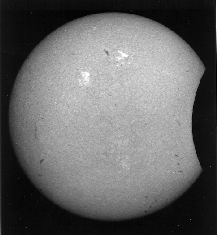What is a Solar Eclipse?
Eclipses of the Sun occur when the Moon passes directly in front of the Sun. This can only happen at the time of a new moon and only at certain points in the Moon's orbit around the Earth. Contrary to popular opinion, solar eclipses are not rare; it is not unusual for there to be two solar eclipses in any one year. In some years, such as the year 2000, there are as many as four.
A total eclipse occurs when the Moon completely covers the face of the Sun. It is, however, rare for a total eclipse to be seen at any particular location because the path of totality on the Earth's surface is typically only 100 kilometres wide. This probably gives rise to the perception that solar eclipses are rare - for anyone not able to travel a total ecipse would indeed be a very rare event.
During a total eclipse, the sky becomes dark, the stars shine and the beautiful corona (the outer atmosphere) of the Sun shines like an irridescent halo around the black Moon. This is a truly awe inspiring event and certainly worth travelling to see. For this reason, there are now quite popular tours to see a total eclipse from the best possible location.
Partial eclipses of the Sun are much more common. During the eclipse the Moon will move slowly across the face of the Sun which will appear as if a very neat bite has been taken out of it. From the time that the Moon first starts to move in front of the Sun to the time it moves right away may take several hours. During a partial eclipse, the sky may darken slightly and the sunlight might appear to be more yellowish than usual.
REMEMBER that it is UNSAFE to view the Sun directly at any time. However, the Sun's image can be projected from a telescope onto white card or a pin hole camera can be constructed.
The picture below shows a bite taken out of the Sun during the Nov 24, 1995 solar eclipse. The image is taken from the Bureau of Meteorology SWS/USAF solar observatory in Learmonth, located near Exmouth in Western Australia.
Material prepared by Richard Thompson






